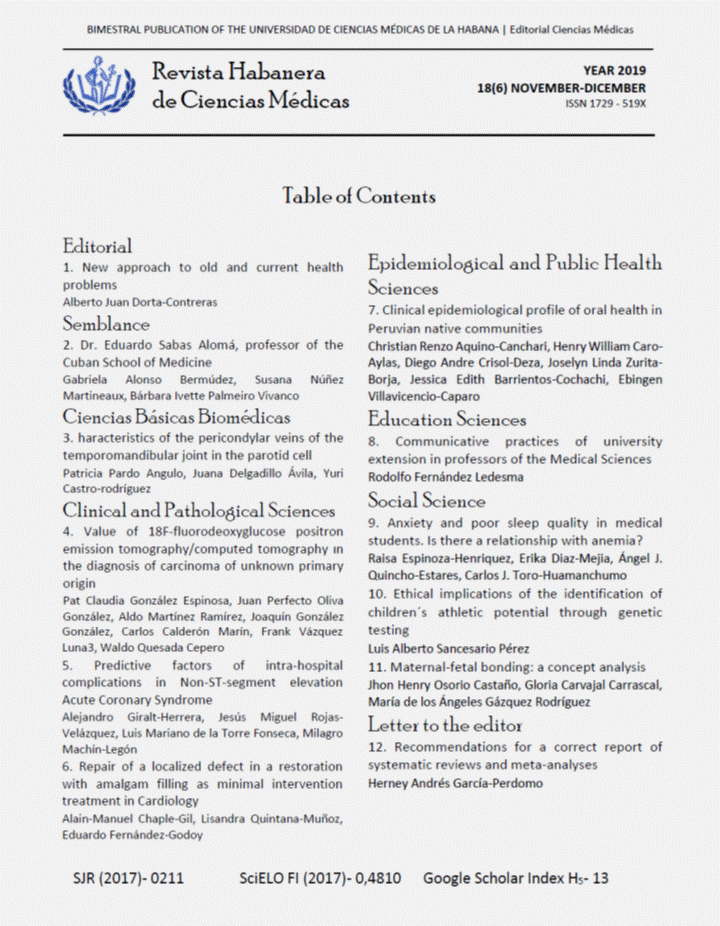Characteristics of the pericondylar veins of the temporomandibular joint in the parotid cell
Keywords:
Pericondylar vein, Retromandibular vein, Temporomandibular joint, Mandibular condyle.Abstract
Introduction: The presence of the pericondylar vein in the area of the temporomandibular joint is scarcely reported in the literature; however, it is present in anatomical dissected preparations and during surgical procedures.
Objective: To determine the characteristics of the pericondylar vein located in the area of the temporomandibular joint, related to the parotid region.
Material and Methods: A cross-sectional, prospective study that included 30 human cadavers that were dissected at the temporomandibular joint level was conducted. The variables analyzed were the distribution of the pericondylar vein, its shape, dimensions and the relationships existing between bony structures.
Results: The 30 cases presented the pericondylar vein that surrounded the external face of the neck of the mandibular condyle; 73,3 % of the veins ended at the level of the retromandibular vein; 38,3 % of them presented an oblique path. The average length of the vein was 2,37 cm and its average diameter was 1.82 mm. The presence of the pericondyleal artery was found in two cases, among other relationships.
Conclusions: The pericondyleal vein was present in all cases, mostly unique and located around the outside of the neck of the mandibular condyle. It most frequently runs into the retromandibular vein. Up to its mouth, it often has an oblique path, from top to bottom and backwards.Downloads
References
1. Moore KI, Dalley AF. Anatomía con orientación Clínica. México D.F: Médica Panamericana; 2007.
2. Ottria L, Candotto V, Guzzo F, Gargari M, Barlattani A. Temporomandibular joint and related structures: anatomical and Histological aspects. J Biol Regul Homeost Agents. [Internet]. 2018;32(2 Suppl. 1):203-207 [Citado 05/01/2019]. Disponible en: http://www.jdentaled.org/content/81/6/752.long
3. Latarjet M, Liard AR. Anatomía humana. 4ta ed. Buenos Aires: Médica Panamericana; 2005.
4. Cesmebasi A, Du Plessis M, Iannatuono M, Shah S, Tubbs RS, Loukas M. A review of the anatomy and clinical significance of adrenal veins. Clin Anat. [Internet]. 2014;27(8):1253-63. [Citado 10/01/0219]. Disponible en: https://onlinelibrary.wiley.com/doi/abs/10.1002/ca.22374
5. Talebzadeh N, Rosenstein TP, Pogrel MA. Anatomy of the structures medial to the temporomandibular joint. Oral Surg Oral Med Oral Pathol Oral Radiol Endod.[Internet]. 1999;88(6):674-8. [Citado 05/01/2019]. Disponible en: https://www.oooojournal.net/article/S1079-2104(99)70008-9/fulltext
6. Sarnat B, Laskin D. The temporomandibular joint: A biological basis for clinical pratice. 4ta ed. Philadelphia: W. B. Saunders Company; 1992.
7. Contreras A, González B, Parra J, Rivas F, Ulloa J, Vielma I, et al. Elementos anatómicos del complejo articular cráneo-mandibular. KIRU. 2017;14(2):157–65.
8. García-Rozado A. Reconstrucción de la articulación temporomandibular: injertos autólogos. Rev Esp Cir Oral Maxilofac. [Internet]. 2005;27: 15-28. [Citado 11/02/2019]. Disponible en: http://www.elsevier.es/es-revista-revista-espanola-cirugia-oral-maxilofacial-300-articulo-reconstruccion-articulacion-temporomandibular-postraumatica-con-S1130055811700119
9. Ricard F. Tratado de Osteopatía Craneal. Articulación temporomandibular. 3ra ed. Madrid: Medos; 2014.
10. Arús NA, da Silva ÁM, Duarte R, da Silveira PF, Vizzotto MB, da Silveira HLD, et al. Teaching Dental Students to Understand the Temporomandibular Joint Using MRI: Comparison of Conventional and Digital Learning Methods. J Dent Educ. [Internet] 2017;81(6):752-8. [Citado 11/02/2019]. Disponible en: http://www.jdentaled.org/content/81/6/752.long
11. Primal’s Picture. 3D Atlas of Human Anatomy of the Head and Neck. Atlas de anatomía interactivo Primal. [Citado 11/02/2019]. Disponible en: https://www-anatomy-tv.ezproxy.usal.es/new_home.aspx?startapp=&startres=&startstudyguide=&S=&ReturnUrl=&lpuserid=&&lm=ip&si=13546064
12. Fuentes R, Cantín M, Ottone NE, Bucchi C. Caracterización de los Componentes Óseos de la Articulación Temporomandibular: Una Revisión de la Literatura. Int J Morphol. [Internet]. 2015; 33(4): 1569-76. [Citado 15/02/2019]. Disponible en: https://scielo.conicyt.cl/scielo.php?script=sci_arttext&pid=S0717-95022015000400062
13. Concha G. Imágenes por resonancia magnética de la articulación temporomandibular. Revista HCUCh. 2007; 18: 121-30.
14. Ballesteros L, García L. Morfometría de la articulación témporomandibular. Un estudio con material de autopsia. Medunab. [Internet]. 1998; 1(2):78-83. [Citado 15/02/2019]. Disponible en: https://revistas.unab.edu.co/index.php/medunab/article/view/399
15. Detamore MS, Athanasiou KA. Structure and function of the temporomandibular joint disc: implications for tissue engineering. J Oral Maxillofac Surg. [Internet]. 2003;61(4):494-506. [Citado 15/02/2019]. Disponible en: https://linkinghub.elsevier.com/retrieve/pii/S0278239102157259
16. Zúñiga S, Vargas A, Vásquez M, Reinoso C, Schulz R, Hormazába, F, Goñi AI. Cirugía reconstructiva de la articulación Temporomandibular. Rev Chile Cirugía. [Internet]. 2013;65(1):85-93. [Citado 12/01/2019]. Disponible en: http://www.scielo.cl/pdf/rchcir/v65n1/art16.pdf
17. Yoshida H, Fujita S, Nishida M, Lizuka T. Localization of lymph capillaries and blood capillaries in human temporomandibular joint discs. J Oral Rehabil. [Internet]. 1999; 26(7):600-5. [Citado 12/01/2019]. Disponible en: https://onlinelibrary.wiley.com/doi/abs/10.1046/j.1365-2842.1999.00402.x?sid=nlm%3Apubmed
18. Soriano FM. Anatomía descriptiva y topográfica de Ia extremidad cefálica: Musculatura masticadora. Labor Dental Clínica. 2014; 15(2): 72-9.
19. Siéssere S, Vitti M, Semprini M, Regalo SC, Iyomasa MM, Dias FJ, et al. Macroscopic and microscopic aspects of the temporomandibular joint related to its clinical implication. Micron. [Internet]. 2008;39(7):852-8. [Citado 12/01/2019] Disponible en: https://www.sciencedirect.com/science/article/pii/S0968432807002089?via%3Dihub



